traction control NISSAN ROGUE HYBRID 2018 Owners Manual
[x] Cancel search | Manufacturer: NISSAN, Model Year: 2018, Model line: ROGUE HYBRID, Model: NISSAN ROGUE HYBRID 2018Pages: 482, PDF Size: 5.79 MB
Page 120 of 482

Side light and headlightindicator light (green)
The side light and headlight indicator light
illuminates when the side light or headlight
position is selected. For additional informa-
tion, refer to “Headlight and turn signal
switch‚ÄĚ in this section.
Slip indicator light
This indicator will blink when the VDC sys-
tem is operating, thus alerting the driver to
the fact that the road surface is slippery
and the vehicle is nearing its traction limits.
You may feel or hear the system working;
this is normal.
The light will blink for a few seconds af ter
the VDC system stops limiting wheel spin.
The
indicator light also comes on
when you place the ignition switch in the
ON position. The light will turn off af ter ap-
proximately 2 seconds if the system is op-
erational. If the light does not come on, or
remains on, have the system checked. It is
recommended that you visit a NISSAN
dealer for this service.
SPORT mode indicator
light
This light illuminates and then turns off
when the ignition switch is placed in the ON
position, and when the SPORT mode is se-
lected.
For additional information, refer to “Con-
tinuously Variable Transmission (CVT)‚ÄĚ in
the ‚ÄúStarting and driving‚ÄĚ section of this
manual.
Turn signal/hazard indicator lights
The appropriate light flashes when the turn
signal switch is activated.
Both lights flash when the hazard switch is
turned on.
Vehicle Dynamic Control (VDC) OFF indicator light
This indicator light comes on when the
VDC OFF switch is pushed to off. This indi-
cates the VDC system has been turned off.
Push the VDC OFF switch again or restart
the hybrid system and the system will op-
erate normally. For additional information, refer to “Vehicle Dynamic Control (VDC) sys-
tem‚ÄĚ in the ‚ÄúStarting and driving‚ÄĚ section of
this manual.
The VDC indicator light also comes on
when you place the ignition switch in the
ON position. The light will turn off af ter
about 2 seconds if the system is opera-
tional. If the
indicator light stays on
while you are driving, have the system
checked. It is recommended that you visit a
NISSAN dealer for this service.
While the VDC system is operating, you
might feel a slight vibration or hear the sys-
tem working when starting the vehicle or
accelerating, but this is normal.
AUDIBLE REMINDERS
Brake pad wear warning
The disc brake pads have audible wear
warnings. When a disc brake pad requires
replacement, it makes a high pitched
scraping sound when the vehicle is in mo-
tion, whether or not the brake pedal is de-
pressed. Have the brakes checked as soon
as possible if the warning sound is heard.
Instruments and controls2-19
Page 285 of 482
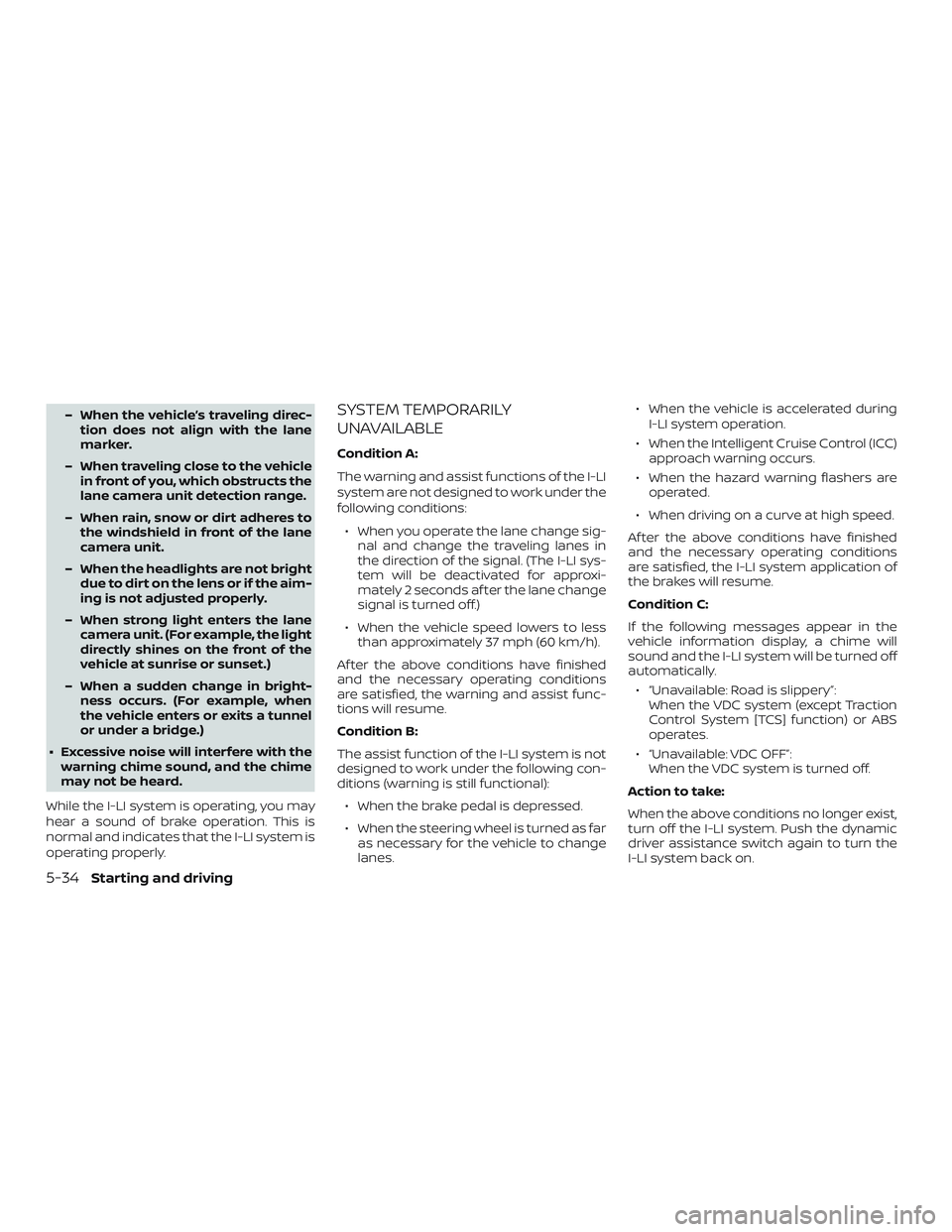
‚Äď When the vehicle‚Äôs traveling direc-tion does not align with the lane
marker.
‚Äď When traveling close to the vehicle in front of you, which obstructs the
lane camera unit detection range.
‚Äď When rain, snow or dirt adheres to the windshield in front of the lane
camera unit.
‚Äď When the headlights are not bright due to dirt on the lens or if the aim-
ing is not adjusted properly.
‚Äď When strong light enters the lane camera unit. (For example, the light
directly shines on the front of the
vehicle at sunrise or sunset.)
‚Äď When a sudden change in bright- ness occurs. (For example, when
the vehicle enters or exits a tunnel
or under a bridge.)
‚ąô Excessive noise will interfere with the warning chime sound, and the chime
may not be heard.
While the I-LI system is operating, you may
hear a sound of brake operation. This is
normal and indicates that the I-LI system is
operating properly.SYSTEM TEMPORARILY
UNAVAILABLE
Condition A:
The warning and assist functions of the I-LI
system are not designed to work under the
following conditions: ‚ąô When you operate the lane change sig- nal and change the traveling lanes in
the direction of the signal. (The I-LI sys-
tem will be deactivated for approxi-
mately 2 seconds af ter the lane change
signal is turned off.)
‚ąô When the vehicle speed lowers to less than approximately 37 mph (60 km/h).
Af ter the above conditions have finished
and the necessary operating conditions
are satisfied, the warning and assist func-
tions will resume.
Condition B:
The assist function of the I-LI system is not
designed to work under the following con-
ditions (warning is still functional): ‚ąô When the brake pedal is depressed.
‚ąô When the steering wheel is turned as far as necessary for the vehicle to change
lanes. ‚ąô When the vehicle is accelerated during
I-LI system operation.
‚ąô When the Intelligent Cruise Control (ICC) approach warning occurs.
‚ąô When the hazard warning flashers are operated.
‚ąô When driving on a curve at high speed.
Af ter the above conditions have finished
and the necessary operating conditions
are satisfied, the I-LI system application of
the brakes will resume.
Condition C:
If the following messages appear in the
vehicle information display, a chime will
sound and the I-LI system will be turned off
automatically. ‚ąô ‚ÄúUnavailable: Road is slippery‚ÄĚ: When the VDC system (except Traction
Control System [TCS] function) or ABS
operates.
‚ąô ‚ÄúUnavailable: VDC OFF‚ÄĚ: When the VDC system is turned off.
Action to take:
When the above conditions no longer exist,
turn off the I-LI system. Push the dynamic
driver assistance switch again to turn the
I-LI system back on.
5-34Starting and driving
Page 330 of 482
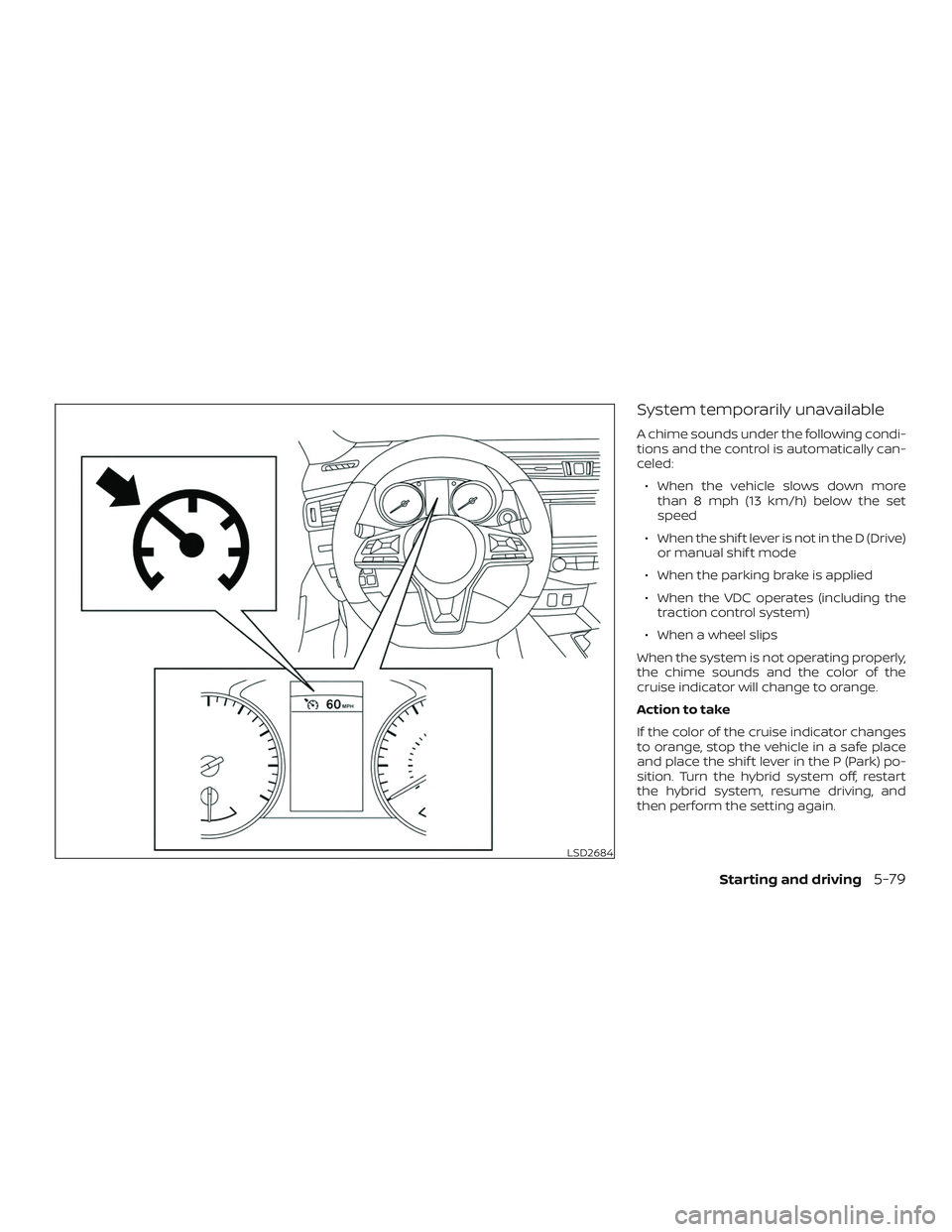
System temporarily unavailable
A chime sounds under the following condi-
tions and the control is automatically can-
celed:‚ąô When the vehicle slows down more than 8 mph (13 km/h) below the set
speed
‚ąô When the shif t lever is not in the D (Drive) or manual shif t mode
‚ąô When the parking brake is applied
‚ąô When the VDC operates (including the traction control system)
‚ąô When a wheel slips
When the system is not operating properly,
the chime sounds and the color of the
cruise indicator will change to orange.
Action to take
If the color of the cruise indicator changes
to orange, stop the vehicle in a safe place
and place the shif t lever in the P (Park) po-
sition. Turn the hybrid system off, restart
the hybrid system, resume driving, and
then perform the setting again.
LSD2684
Starting and driving5-79
Page 358 of 482
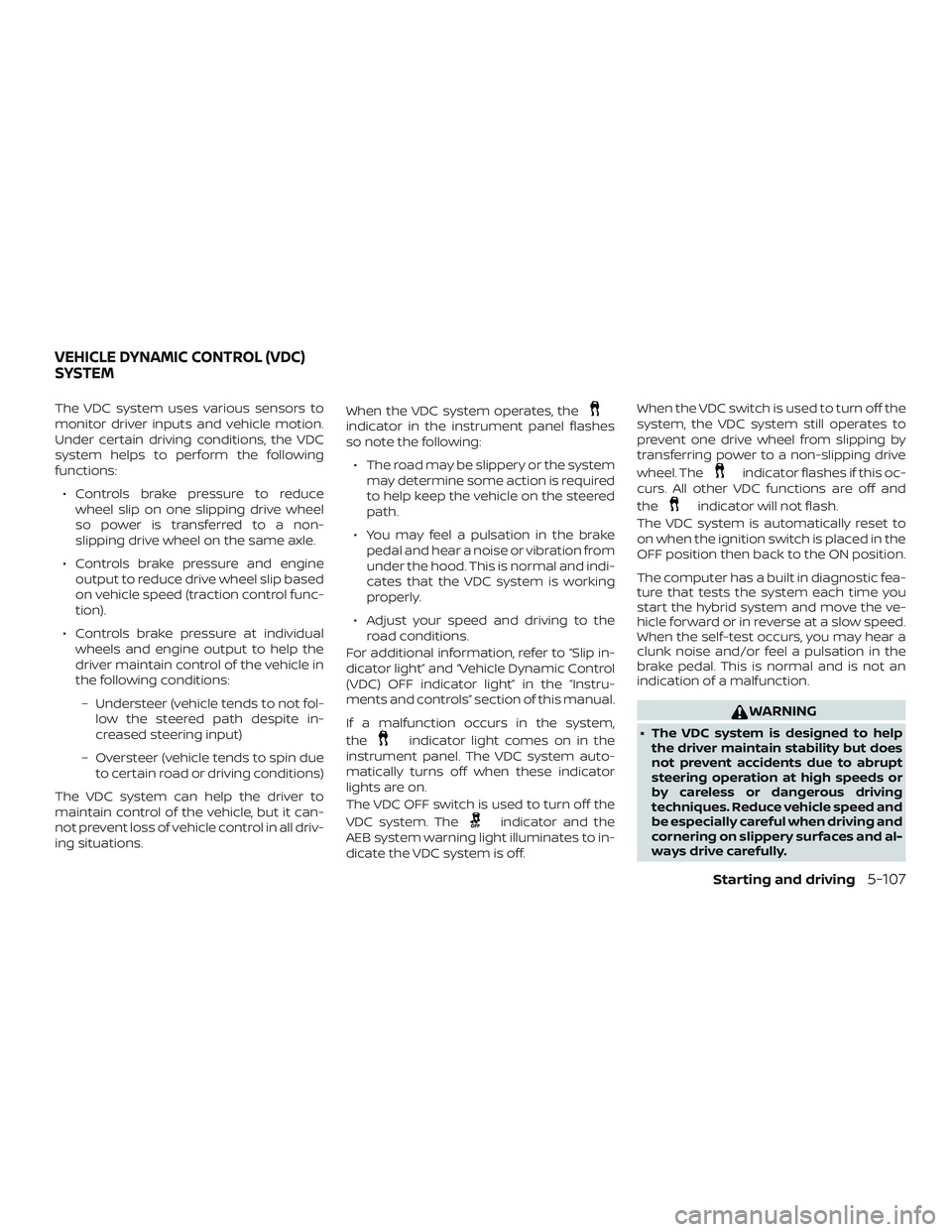
The VDC system uses various sensors to
monitor driver inputs and vehicle motion.
Under certain driving conditions, the VDC
system helps to perform the following
functions:‚ąô Controls brake pressure to reduce wheel slip on one slipping drive wheel
so power is transferred to a non-
slipping drive wheel on the same axle.
‚ąô Controls brake pressure and engine output to reduce drive wheel slip based
on vehicle speed (traction control func-
tion).
‚ąô Controls brake pressure at individual wheels and engine output to help the
driver maintain control of the vehicle in
the following conditions:
‚Äď Understeer (vehicle tends to not fol- low the steered path despite in-
creased steering input)
‚Äď Oversteer (vehicle tends to spin due to certain road or driving conditions)
The VDC system can help the driver to
maintain control of the vehicle, but it can-
not prevent loss of vehicle control in all driv-
ing situations. When the VDC system operates, the
indicator in the instrument panel flashes
so note the following:
‚ąô The road may be slippery or the system may determine some action is required
to help keep the vehicle on the steered
path.
‚ąô You may feel a pulsation in the brake pedal and hear a noise or vibration from
under the hood. This is normal and indi-
cates that the VDC system is working
properly.
‚ąô Adjust your speed and driving to the road conditions.
For additional information, refer to “Slip in-
dicator light‚ÄĚ and ‚ÄúVehicle Dynamic Control
(VDC) OFF indicator light‚ÄĚ in the ‚ÄúInstru-
ments and controls‚ÄĚ section of this manual.
If a malfunction occurs in the system,
the
indicator light comes on in the
instrument panel. The VDC system auto-
matically turns off when these indicator
lights are on.
The VDC OFF switch is used to turn off the
VDC system. The
indicator and the
AEB system warning light illuminates to in-
dicate the VDC system is off. When the VDC switch is used to turn off the
system, the VDC system still operates to
prevent one drive wheel from slipping by
transferring power to a non-slipping drive
wheel. The
indicator flashes if this oc-
curs. All other VDC functions are off and
the
indicator will not flash.
The VDC system is automatically reset to
on when the ignition switch is placed in the
OFF position then back to the ON position.
The computer has a built in diagnostic fea-
ture that tests the system each time you
start the hybrid system and move the ve-
hicle forward or in reverse at a slow speed.
When the self-test occurs, you may hear a
clunk noise and/or feel a pulsation in the
brake pedal. This is normal and is not an
indication of a malfunction.
WARNING
‚ąô The VDC system is designed to help the driver maintain stability but does
not prevent accidents due to abrupt
steering operation at high speeds or
by careless or dangerous driving
techniques. Reduce vehicle speed and
be especially careful when driving and
cornering on slippery surfaces and al-
ways drive carefully.
VEHICLE DYNAMIC CONTROL (VDC)
SYSTEM
Starting and driving5-107
Page 365 of 482
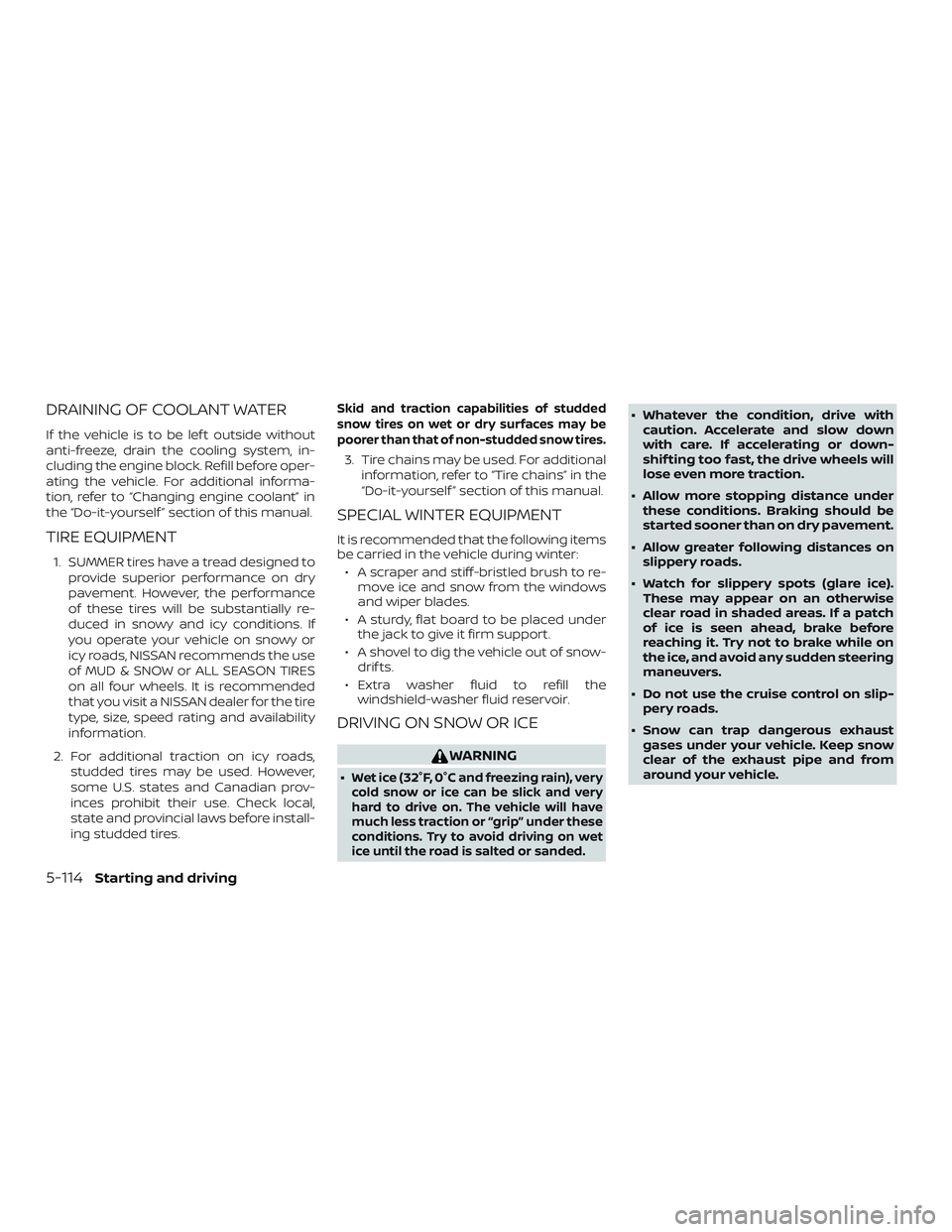
DRAINING OF COOLANT WATER
If the vehicle is to be lef t outside without
anti-freeze, drain the cooling system, in-
cluding the engine block. Refill before oper-
ating the vehicle. For additional informa-
tion, refer to ‚ÄúChanging engine coolant‚ÄĚ in
the ‚ÄúDo-it-yourself ‚ÄĚ section of this manual.
TIRE EQUIPMENT
1. SUMMER tires have a tread designed toprovide superior performance on dry
pavement. However, the performance
of these tires will be substantially re-
duced in snowy and icy conditions. If
you operate your vehicle on snowy or
icy roads, NISSAN recommends the use
of MUD & SNOW or ALL SEASON TIRES
on all four wheels. It is recommended
that you visit a NISSAN dealer for the tire
type, size, speed rating and availability
information.
2. For additional traction on icy roads, studded tires may be used. However,
some U.S. states and Canadian prov-
inces prohibit their use. Check local,
state and provincial laws before install-
ing studded tires.
Skid and traction capabilities of studded
snow tires on wet or dry surfaces may be
poorer than that of non-studded snow tires.
3. Tire chains may be used. For additionalinformation, refer to ‚ÄúTire chains‚ÄĚ in the
‚ÄúDo-it-yourself ‚ÄĚ section of this manual.
SPECIAL WINTER EQUIPMENT
It is recommended that the following items
be carried in the vehicle during winter:
‚ąô A scraper and stiff-bristled brush to re- move ice and snow from the windows
and wiper blades.
‚ąô A sturdy, flat board to be placed under the jack to give it firm support.
‚ąô A shovel to dig the vehicle out of snow- drif ts.
‚ąô Extra washer fluid to refill the windshield-washer fluid reservoir.
DRIVING ON SNOW OR ICE
WARNING
‚ąôWet ice (32¬įF, 0¬įC and freezing rain), very
cold snow or ice can be slick and very
hard to drive on. The vehicle will have
much less traction or ‚Äúgrip‚ÄĚ under these
conditions. Try to avoid driving on wet
ice until the road is salted or sanded.
‚ąô Whatever the condition, drive with caution. Accelerate and slow down
with care. If accelerating or down-
shif ting too fast, the drive wheels will
lose even more traction.
‚ąô Allow more stopping distance under these conditions. Braking should be
started sooner than on dry pavement.
‚ąô Allow greater following distances on slippery roads.
‚ąô Watch for slippery spots (glare ice). These may appear on an otherwise
clear road in shaded areas. If a patch
of ice is seen ahead, brake before
reaching it. Try not to brake while on
the ice, and avoid any sudden steering
maneuvers.
‚ąô Do not use the cruise control on slip- pery roads.
‚ąô Snow can trap dangerous exhaust gases under your vehicle. Keep snow
clear of the exhaust pipe and from
around your vehicle.
5-114Starting and driving
Page 467 of 482
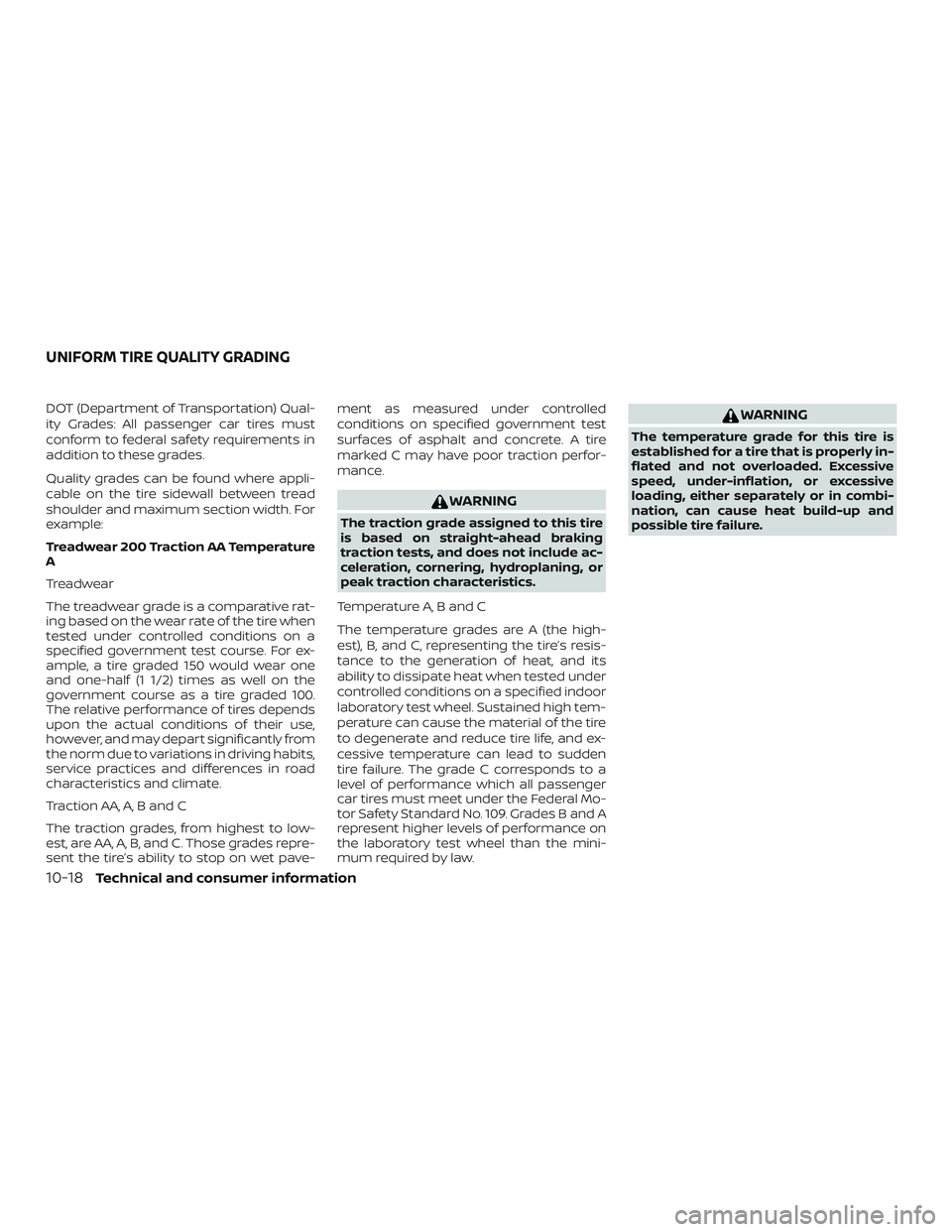
DOT (Department of Transportation) Qual-
ity Grades: All passenger car tires must
conform to federal safety requirements in
addition to these grades.
Quality grades can be found where appli-
cable on the tire sidewall between tread
shoulder and maximum section width. For
example:
Treadwear 200 Traction AA Temperature
A
Treadwear
The treadwear grade is a comparative rat-
ing based on the wear rate of the tire when
tested under controlled conditions on a
specified government test course. For ex-
ample, a tire graded 150 would wear one
and one-half (1 1/2) times as well on the
government course as a tire graded 100.
The relative performance of tires depends
upon the actual conditions of their use,
however, and may depart significantly from
the norm due to variations in driving habits,
service practices and differences in road
characteristics and climate.
Traction AA, A, B and C
The traction grades, from highest to low-
est, are AA, A, B, and C. Those grades repre-
sent the tire’s ability to stop on wet pave-ment as measured under controlled
conditions on specified government test
surfaces of asphalt and concrete. A tire
marked C may have poor traction perfor-
mance.
WARNING
The traction grade assigned to this tire
is based on straight-ahead braking
traction tests, and does not include ac-
celeration, cornering, hydroplaning, or
peak traction characteristics.
Temperature A, B and C
The temperature grades are A (the high-
est), B, and C, representing the tire’s resis-
tance to the generation of heat, and its
ability to dissipate heat when tested under
controlled conditions on a specified indoor
laboratory test wheel. Sustained high tem-
perature can cause the material of the tire
to degenerate and reduce tire life, and ex-
cessive temperature can lead to sudden
tire failure. The grade C corresponds to a
level of performance which all passenger
car tires must meet under the Federal Mo-
tor Safety Standard No. 109. Grades B and A
represent higher levels of performance on
the laboratory test wheel than the mini-
mum required by law.
WARNING
The temperature grade for this tire is
established for a tire that is properly in-
flated and not overloaded. Excessive
speed, under-inflation, or excessive
loading, either separately or in combi-
nation, can cause heat build-up and
possible tire failure.
UNIFORM TIRE QUALITY GRADING
10-18Technical and consumer information